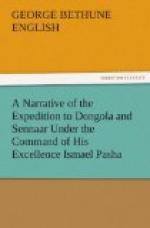The river Nile has been represented, and I think with justice, as one of the wonders of the world. I do not consider it as meriting this appellation so much on account of its periodical and regular floods, in which respect it is resembled by several other rivers, as on account of another circumstance, in which, so far as I know, it is without a parallel.
The Nile resembles the path of a good man in a wicked and worthless world. It runs through a desert—a dry, barren, hideous desert; on the parts of which adjoining its course it has deposited the richest soil in the world, which it continually waters and nourishes. This soil has been the source of subsistence to several powerful nations who have established and overthrown mighty kingdoms, and have originated the arts, the religion, the learning and the civilization of the greater part of the ancient world. These nations, instructors and pupils, have perished; but the remains of their stupendous labors, the pyramids and the temples of Egypt, Nubia, and in the countries now visited for the first time, at least for many ages, by minds capable of appreciating the peoples who erected them, are more than sufficient to excite astonishment and respect for the nations who founded them. The few in stances that I have mentioned are such as have presented themselves to my notice in sailing up the river, without my having the opportunity to scrutinize them particularly, or time or means to pursue any researches in the vicinity of those I have seen, by which doubtless many more would be discovered. Some future traveler in these interesting and remote regions, who may have the power and the means to traverse at his leisure the banks and islands I have seen and admired, will, I believe, find his labors rewarded by discoveries which will interest the learned, and gratify the curious.




